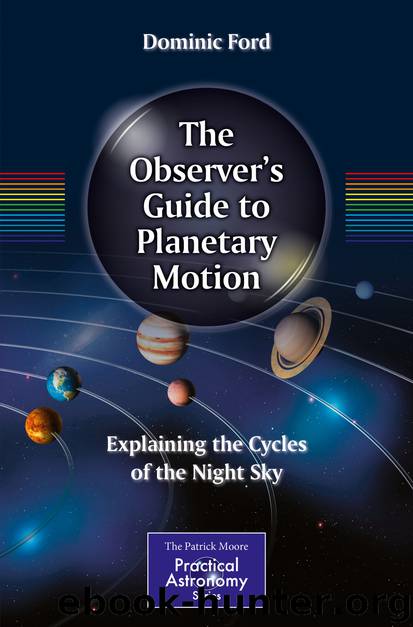The Observer's Guide to Planetary Motion by Dominic Ford

Author:Dominic Ford
Language: eng
Format: epub
Publisher: Springer New York, New York, NY
Curiously, it also has the effect of pulling the Moon forward in its orbit: the tidal bulge nearest to the Moon is always a little ahead of the position on the Earth’s surface that the Moon lies directly above. Just as the Earth is pulled clockwise, in opposition to its rotation, the Moon is pulled counterclockwise by this gravitational tussle, speeding it up in its orbit. This means that the Moon is acquiring energy from the Earth’s rotation, and gradually migrating into a more distant orbit around the Earth, at a rate of around 38 mm per year.
Given time, the Moon could acquire enough energy by this mechanism to leave the Earth’s orbit altogether, since there is more than three times more energy stored in the Earth’s rotation than would be needed to lift the Moon completely out of orbit around it. However, at the present rate of transfer of energy the process would take over 10 billion years, by which time the Sun will already have become a red giant star and have long since engulfed both the Earth and the Moon.
More imminently, the Moon’s gradual recession away from the Earth puts in danger the coincidence that makes total solar eclipses possible—the coincidence that while the Moon’s diameter is 390 times smaller than that of the Sun, the Moon is also 390 times closer to the Earth. As the Moon grows more distant, it will present an ever-smaller disk in the night sky. In around 100 million years’ time, anyone still living on Earth will see the last ever total solar eclipse before the Moon shrinks to a size where it is no longer able to entirely cover the Sun.
How does this explain why the Moon always keeps the same face turned towards the Earth? The Earth is not the only body in the solar system to feel tides. The Moon feels tides from the Earth’s gravitational field, and in fact the tides that the Moon feels are considerably stronger than our own, since the Earth is more massive and has a stronger gravitational field. Although tides are normally associated with the oceans on Earth, they also act on the solid surfaces of any rocky body to produce what are called solid tides. These are much less pronounced than the ocean tides on Earth because rocks are not very elastic, but they are still significant. Just as the Moon’s tidal pull on the Earth slows its rotation, so in the past the Earth’s tidal pull on the Moon would have slowed its rotation.
This slowing came to an eventual endpoint when the Moon spun about its rotation axis at exactly the same rate as it circles around the Earth. From the Earth, this rate of rotation means that the Moon always presents the same face to the Earth, as we have seen. From the Moon, however, it means that the Earth is always lies directly overhead at exactly the same point on the lunar surface. It means that any observer
Download
This site does not store any files on its server. We only index and link to content provided by other sites. Please contact the content providers to delete copyright contents if any and email us, we'll remove relevant links or contents immediately.
| Biomathematics | Differential Equations |
| Game Theory | Graph Theory |
| Linear Programming | Probability & Statistics |
| Statistics | Stochastic Modeling |
| Vector Analysis |
Modelling of Convective Heat and Mass Transfer in Rotating Flows by Igor V. Shevchuk(6391)
Weapons of Math Destruction by Cathy O'Neil(6139)
Factfulness: Ten Reasons We're Wrong About the World – and Why Things Are Better Than You Think by Hans Rosling(4691)
Descartes' Error by Antonio Damasio(3229)
A Mind For Numbers: How to Excel at Math and Science (Even If You Flunked Algebra) by Barbara Oakley(3217)
Factfulness_Ten Reasons We're Wrong About the World_and Why Things Are Better Than You Think by Hans Rosling(3197)
TCP IP by Todd Lammle(3131)
Fooled by Randomness: The Hidden Role of Chance in Life and in the Markets by Nassim Nicholas Taleb(3043)
Applied Predictive Modeling by Max Kuhn & Kjell Johnson(3018)
The Tyranny of Metrics by Jerry Z. Muller(3000)
The Book of Numbers by Peter Bentley(2908)
The Great Unknown by Marcus du Sautoy(2645)
Once Upon an Algorithm by Martin Erwig(2598)
Easy Algebra Step-by-Step by Sandra Luna McCune(2578)
Lady Luck by Kristen Ashley(2530)
Practical Guide To Principal Component Methods in R (Multivariate Analysis Book 2) by Alboukadel Kassambara(2497)
Police Exams Prep 2018-2019 by Kaplan Test Prep(2482)
All Things Reconsidered by Bill Thompson III(2355)
Linear Time-Invariant Systems, Behaviors and Modules by Ulrich Oberst & Martin Scheicher & Ingrid Scheicher(2332)
